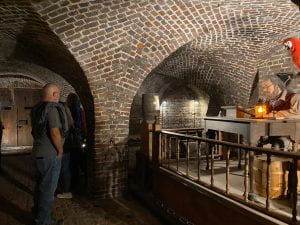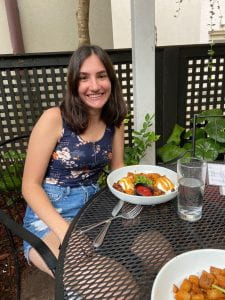Some Fun Facts of the Building
I went to the Old Exchange and Provost Dungeon on 22 E Bay Street, in Charleston, SC. It was really cool. While I was there, I learned about the wild history of the building. The tour guide talked about how the building was made to stand out and be seen by people walking around Charleston. It was built in 1771 by slave labor, as most of everything was in the South back in the day. Each brick was made by hand, one at a time, and in some of the bricks, you could still see fingerprints and handprints left behind from the people who were unfortunately forced to build it. The most defining feature, the arches, were made with tons of bricks and tons of prayers, and after numerous hurricanes and earthquakes, they are still holding up beautifully today.
For years, the building was used as storage, and interestingly enough, the Americans managed to stuff seven tons of gunpowder into a makeshift room in the building for twenty years during the American Revolution. Right after it was first hidden, the British took over the building and turned it into a dungeon. During their entire time in the building, the British did not find the room with all the gunpowder. After the war, they left, of course, and the gunpowder went back to its original American owners.
Inside the Building
When you enter, you are greeted by a small gift shop right in front of you. On either side are registers where you buy your tickets for the tour. After buying your tickets, you are told to go to the elevator, which brings you to the basement, A.K.A, the dungeon (dun, dun, dunnnn). Jokes aside, the basement was really cool. You go down there and see the arches first (and they aren’t very tall, so you may want to duck your head if you’re tall). As you walk around more, you begin to see the mannequins they have to show the types of people who were down there, and how the curators think the dungeon was set up under British control.

Me and Gus (yes, that is his actual name)




This is the fake wall of the room where the seven tons of gun powder was that was hidden from the British


Interpreting the Building
The tour guide did a fantastic job explaining how slavery was the backbone of Charleston infrastructure and development. Unfortunately, most, if not all, of the historical buildings in the downtown area were built from enslaved people (including the College of Charleston that I attend), which of course, is not okay, but that was how the South was run back then. We have talked about this numerous times in the Southern Studies course I am taking. We have read numerous articles and poems that discuss what life was like for those who were enslaved, and life was obviously not easy for them. I am very glad that the tour guide made sure to talk about the darker history behind the building, including the literal slave market that took place outside the building because hosting it inside was just “too expensive” for the plantation owners.
The site definitely reflects the historical southern stereotype of the South, with strong ties to slavery, racism, plantations, and war. The site is clearly an important part of Charleston’s identity, and you can surely tell by looking at its colonial style features, along with the fact that it was such a major part of the city.
Overall, this historical site tells such a huge story of the city of Charleston. This building has been through a lot, just like many of the people who have been involved with it throughout Charleston’s history. I highly recommend a visit here if you are in the Charleston area and want to learn more about this beautiful city’s crazy history.





